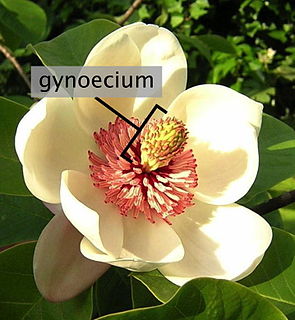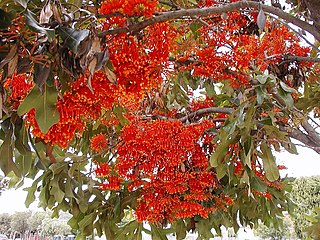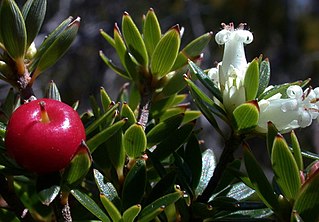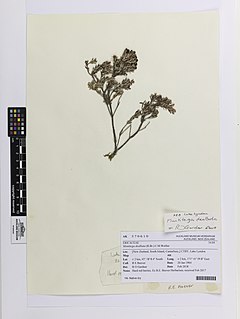
The stamen is the pollen-producing reproductive organ of a flower. Collectively the stamens form the androecium.

Violaceae is a family of flowering plants established in 1802, consisting of about 1000 species in about 25 genera. It takes its name from the genus Viola, the violets and pansies.

Tribulus is a genus of plants in the family Zygophyllaceae and found in diverse climates and soils worldwide from latitudes 35°S to 47°N. The best-known member is T. terrestris, a widespread invasive species and weed.

Flindersia is a genus of 17 species of small to large trees in the family Rutaceae. They have simple or pinnate leaves, flowers arranged in panicles at or near the ends of branchlets and fruit that is a woody capsule containing winged seeds. They grow naturally in Australia, the Moluccas, New Guinea and New Caledonia.

Leucopogon is a genus of about 150-160 species of shrubs or small trees in the family Ericaceae, in the section of that family formerly treated as the separate family Epacridaceae. They are native to Australia, New Zealand, New Caledonia, the western Pacific Islands and Malaysia, with the greatest species diversity in southeastern Australia. Plants in this genus have leaves with a few more or less parallel veins, and tube-shaped flowers usually with a white beard inside.

Gynoecium is most commonly used as a collective term for the parts of a flower that produce ovules and ultimately develop into the fruit and seeds. The gynoecium is the innermost whorl of a flower; it consists of pistils and is typically surrounded by the pollen-producing reproductive organs, the stamens, collectively called the androecium. The gynoecium is often referred to as the "female" portion of the flower, although rather than directly producing female gametes, the gynoecium produces megaspores, each of which develops into a female gametophyte which then produces egg cells.

In the flowering plants, an ovary is a part of the female reproductive organ of the flower or gynoecium. Specifically, it is the part of the pistil which holds the ovule(s) and is located above or below or at the point of connection with the base of the petals and sepals. The pistil may be made up of one carpel or of several fused carpels, and therefore the ovary can contain part of one carpel or parts of several fused carpels. Above the ovary is the style and the stigma, which is where the pollen lands and germinates to grow down through the style to the ovary, and, for each individual pollen grain, to fertilize one individual ovule. Some wind pollinated flowers have much reduced and modified ovaries.

Asteliaceae is a family of flowering plants, placed in the order Asparagales of the monocots.

Stenocarpus is a genus of about 22 species of flowering plants in the family Proteaceae. They are trees or shrubs with variably-shaped leaves, zygomorphic, bisexual flowers, the floral tube opening on the lower side before separating into four parts, followed by fruit that is usually a narrow oblong or cylindrical follicle.

Leea is a genus of plants that are distributed throughout Northern and eastern Australia, New Guinea, South and Southeast Asia and parts of Africa. The APG IV system places Leea in the subfamily Leeoideae (Vitaceae). Leea is now placed in the family Vitaceae having previously been placed in its own family, Leeaceae, based on morphological differences between it and other Vitaceae genera. These differences include ovule number per locule, carpel number, and the absence or presence of a staminoidal tube and floral disc. Pollen structure has also been examined for taxonomic demarcation, though studies have concluded that the pollen of Leeaceae and Vitaceae suggests the families should remain separate while other studies conclude that Leea should be included in Vitaceae.

Leptecophylla is a genus of flowering plants in the family Ericaceae. The genus is native to southeastern Australia, New Zealand, Papua New Guinea and the Pacific Islands. Some species in this genus were formerly classified within the genera Cyathodes, Lissanthe, Styphelia and Trochocarpa.

Leptecophylla juniperina is a species of flowering plant in the family Ericaceae. The species is native to New Zealand and the Australian states of Tasmania and Victoria. The plant's fruit is edible, raw or cooked. Plants grow best in areas with moderate winters and cool moist summers.

Chloanthes is a genus of four species of flowering plants in the family Lamiaceae and is endemic to Australia. Plants in this genus are shrubs with hairy foliage, blistered or wrinkly leaves and flowers with five petals fused at the base, usually with two "lips".

The Solanaceae, or nightshades, are a family of flowering plants that ranges from annual and perennial herbs to vines, lianas, epiphytes, shrubs, and trees, and includes a number of agricultural crops, medicinal plants, spices, weeds, and ornamentals. Many members of the family contain potent alkaloids, and some are highly toxic, but many—including tomatoes, potatoes, eggplant, bell and chili peppers—are used as food. The family belongs to the order Solanales, in the asterid group and class Magnoliopsida (dicotyledons). The Solanaceae consists of about 98 genera and some 2,700 species, with a great diversity of habitats, morphology and ecology.

Cyathodes straminea, also known as false-whorled cheeseberry, is a species of flowering plant in the family Ericaceae endemic to Tasmania, where it grows as an alpine to subalpine shrub with a spreading habit. The generic name Cyathodes was derived from Greek "Cyath" = cup and "odes" = like, referring to the ovary encircled by cup-shaped nectary.

Montitega is a genus of flowering plants belonging to the family Ericaceae.

Leptecophylla parvifolia, commonly known as the mountain pinkberry, is a small to medium sized shrub within the Ericaceae family and is endemic to the highlands of Tasmania. This species was first collected and documented in 1804 by Robert Brown and was formerly included in the Cythodes genus. It was then as noted as subspecies of Leptecophylla junipernia but in 2018, was classified as its own species

In botany, floral morphology is the study of the diversity of forms and structures presented by the flower, which, by definition, is a branch of limited growth that bears the modified leaves responsible for reproduction and protection of the gametes, called floral pieces.

Epacridoideae is a subfamily of the family Ericaceae. The name StyphelioideaeSweet is also used. The subfamily contains around 35 genera and 545 species. Many species are found in Australasia, others occurring northwards through the Pacific to Southeast Asia, with a small number in South America.


















